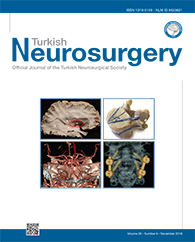2Istanbul Medipol University, School of Medicine, Department of Medical Pharmacology, Istanbul, Turkey
3Istanbul Medipol University School of Medicine, Department of Orthopaedic and Traumatology, Istanbul, Turkey
4Istanbul Esenyurt University, Esencan Hospital, Department of Neurosurgery, Istanbul, Turkey
5Namik Kemal University, School of Medicine, Department of Infectious Diseases, Tekirdag, Turkey DOI : 10.5137/1019-5149.JTN.21341-17.2 AIM: To determine whether the washing of implants and autogenous bone grafts with rifampicin, and the irrigation of the surgical field using diluted rifampicin, have any significant effect on the prevention of spinal implant infections.
MATERIAL and METHODS: A total of 166 consecutive lumbar stenosis and spondylolisthesis patients undergoing lumbar instrumentation between 2012 and 2016 were analyzed retrospectively. The patients were divided into two groups. Group I (n=85) included patients whose implants were washed with rifampicin immediately before insertion and whose surgical fields were irrigated with diluted rifampicin immediately after insertion. Group II (n=81) included the cases without rifampicin application. Both groups were matched for age, sex, body mass index, and surgical indication. The infection rates of the groups were compared during the first 2 postoperative years.
RESULTS: No significant difference was found between the infection rate in Group I and Group II. Only 1 case had surgical site infection (SSI) in Group I, a rate of 1.17% (1 of 85 patients), whereas 2 patients had SSI in Group II, a rate of 2.46% (2 of 81 patients).
CONCLUSION: Peroperative washing of implants with rifampicin and irrigation of the surgical field using diluted rifampicin have not been found to be significantly effective in preventing or reducing spinal implant infections. However, further studies with larger series need to be carried out to verify these results.
Keywords : Implant, Infection rate, Irrigation, Spine, Rifampicin




